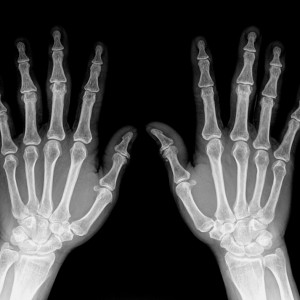 In a new study entitled “Vascular calcifications on hand radiographs in rheumatoid arthritis and associations with autoantibodies, cardiovascular risk factors and mortality” researchers investigated the link between vascular calcifications in rheumatoid arthritis patients hands and the risk for cardiovascular disease and mortality. The study was published in the journal Rheumatology (Oxford Journals).
In a new study entitled “Vascular calcifications on hand radiographs in rheumatoid arthritis and associations with autoantibodies, cardiovascular risk factors and mortality” researchers investigated the link between vascular calcifications in rheumatoid arthritis patients hands and the risk for cardiovascular disease and mortality. The study was published in the journal Rheumatology (Oxford Journals).
Patients with rheumatoid arthritis (RA), a chronic inflammatory disorder mainly affecting the joints in hands and feet, exhibit a significant increased risk for cardiovascular disease, which often culminates in patients’ death. Notably, however, very limited research has focused on the link between vascular calcifications (detected by radiography) and cardiovascular events in RA patients.
Here, researchers at the Division of Rheumatic Diseases, UT Southwestern in Dallas and the Division of Rheumatology and Immunology at Omaha Veterans Affairs Medical Center in Nebraska, along with colleagues at other institutions, determined if examining vascular calcifications in the hands of RA patients by commonly performed radiographs could inform clinicians on the relative mortality risk due to cardiovascular disease. To this end, authors examined hand radiographs from 906 RA patients who participated in a previous observational study, the Veterans Affairs Rheumatoid Arthritis (VARA), which collected digitized hand radiographs.
Upon examination, radiographs were classified as positive or negative for vascular calcifications and patients risk for cardiovascular disease were associated with the vascular calcification profile. Additionally, authors measured cytokines and anti–citrullinated protein antibodies (ACPAs), since recent reports suggested the presence of ACPAs was associated with increased cardiovascular risk in Atherosclerosis.
The team discovered radiographic vascular calcifications in 99 patients (thus corresponding to 11% of patients total population), and found that the Il-4 and TNFa cytokines (TNFa is actually associated to coronary calcium burden in RA) together with ACPAs, vimentin and ApoE (Apolipoprotein E) were significantly more expressed in patients with vascular calcifications. Additionally, authors observed patients with vascular calcifications exhibited a greater all-cause mortality risk, which was independent of already known factors related to cardiovascular events, such as comorbid chronic kidney disease. The authors suggest future studies should clarify the association of IL-4 and ACPAs with vascular calcifications and their potential use as markers for cardiovascular disease risk in patients with rheumatoid arthritis.


